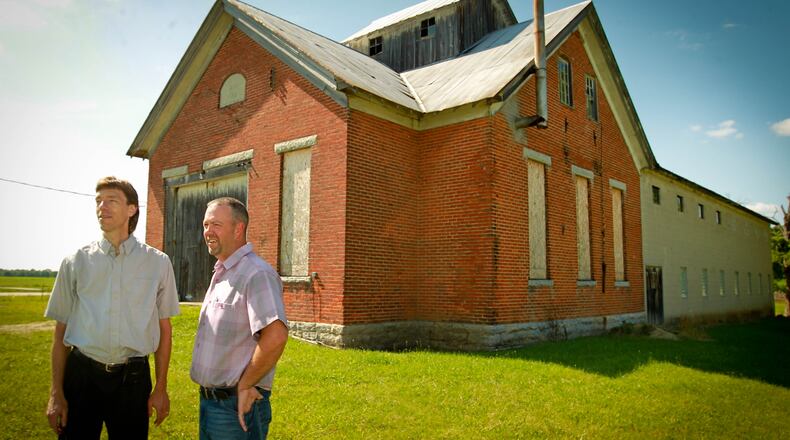Ohio wines by the numbers
• 227: the number of licensed wineries in the state, up from 37 in 1985
• 2,000: the number of acres of grapes cultivated in Ohio
• 1.2 million: the number of gallons of wines produced in the Buckeye state in 2014
Source: Ohio Grape Industries Commision, Ohio Wine Producers Association
A new winery is in the fermentation stage in northern Preble County, and its founders have purchased a 125-year-old one-room schoolhouse and intend to refurbish it to serve as the winery’s tasting room and production area.
The Olde Schoolhouse Vineyard & Winery is the brainchild of Mark Zdobinski and Jim Meeks, who serve on the Preble County Farm Bureau Council together and who also share enthusiasm for wine. The co-founders purchased eight acres last fall that included a 125-year-old one-room schoolhouse near the corner of Ohio 127 and Ohio 726 north of Eaton. They planted 1,000 grapevines this spring, and two weeks ago, they applied for a license from the Ohio Division of Liquor Control.
If all goes well, “We plan to open the spring of next year,” said Zdobinski, who will make Olde Schoolhouse’s wines while his business partner serves as vineyard manager.
It will take four years for the newly planted grapevines to produce a commercially viable crop, “so we’ll be buying grapes for a few years” before the winery can produce an estate-grown wine, Zdobinski said.
“We plan to offer 14 wines in our tasting room, across a broad spectrum of dry to sweet, along with a couple of fruit wines,” Zdobinski said. “We’ll buy mostly regional grapes, but we’ll bring in some grapes from California to make chardonnay and cabernet sauvignon.”
Zdobinski has some experience in the art of fermentation. He has been an amateur winemaker for more than 20 years, and recently captured multiple awards for his wines at some high-level competitions, including a “Best of Show” white-wine award in the 2015 WineMaker International Amateur Wine Competition and a Double Gold for a white variety at the 2014 Indy International Wine Competition.
“My wine is my passion,” Zdobinski said. “I get a lot of reward in seeing people respond favorably to something I’ve made with my hands.”
Zdobinski isn’t alone in his passion, or in his desire to open a winery. Ohio now has nearly 230 licensed wineries, up from 37 in 1985 — and more than half of the state’s wineries have been open for five years or less, according to Donniella Winchell, executive director of the Ohio Wine Producers Association. Olde Schoolhouse will become the ninth winery in the Miami Valley, including relatively recent additions A.R. Winery and Kennedy Vineyard, both in Darke County.
According to an economic-impact study commissioned by the Ohio Department of Agriculture and released in May 2014, Ohio wine and grapes accounted for $786 million in economic activity in 2012, a 34 percent increase from 2008. The industry provides 5,291 full-time jobs, 1,200 more than in 2008. Nearly 2.75 million people visit Ohio wineries annually.
But launching a winery is not for the faint of heart. The polar vortex of January 2014 inflicted what is believed to be the worst damage to grapevines and vineyards on record in Ohio, according to Imed Dami, associate professor and state viticulturist with the Ohio State University’s College of Food, Agricultural, and Environmental Sciences.
Dami led a survey of grape growers last year following the polar vortex, which sent temperatures plummeting to as low at -27 degrees in some Ohio vineyards. In the Dayton area, wind chills reached -40 degrees, and on Jan. 6, the temperature remained below zero for 28 consecutive hours.
Temperatures that cold can, at the very least, destroy a grapevine’s buds that would have produced grapes for the coming year’s crop. It can also kill a vine outright, or weaken it so it is more susceptible to infection from other vine scourges. And the grape varietals that are most vulnerable to damage from frigid temperatures are those “vinifera” varieties of European heritage that are the most well-known to, and popular with, wine drinkers, such as chardonnay, pinot noir and riesling.
Zdobinski steered clear of those varietals in his vineyards, planting LaCrescent, a white-wine grape, and Marquette, a red-wine grape, both of which are relatively hardy and can survive chilly Preble County winters.
The winery’s future tasting room will become the founders’ primary focus the rest of 2015. The boarded-up building was built in 1890 and operated as a schoolhouse until 1929. A seed company utilized the building for decades afterward, but it has been vacant for more than 30 years, Zdobinski said.
“It’s still in reasonably good shape,” he said. “We intend to try to keep the schoolhouse theme, and we’re still in search of photos and any information about the schoolhouse’s history.”
For more information or to monitor the winery's progress, go to the Olde Schoolhouse Vineyard & Winery Facebook page at www.facebook.com/oldeschoolhousewinery.
About the Author

